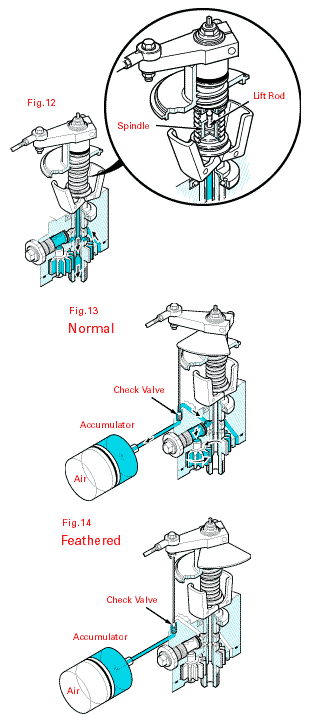|
McCauley Prop Governor Unfeathering
Accumulator
McCauley Contact Info
Product
Support:
Hal
Bohannon, Manager
Gary Peak, Service Engineer
Chris Bell, Service Engineer
James Williams , Technical Training Administrator
Leah Hammar, Engineering Technical Aide
Mailing
Address:
McCauley Propeller Systems
PO Box 7704
Wichita, KS 67277-7704
Phone:
316-831-4021
Toll Free:
800-621-PROP (7767)
Fax: 316-831-3858
Support:
productsupport@mccauley.textron.com
Explanation:
http://www.mccauley.textron.com/prop/prop-tech/pg02var-ptch.html
A full-feathering
propeller system is normally used only on twin-engine aircraft. If one
of the engines fails in flight, the propeller on the idle engine can
rotate or ?windmill,? causing increased drag. To prevent this, the
propeller can be ?feathered? (turned to a very high pitch), with the
blades almost parallel to the airstream. This eliminates asymmetric
drag forces caused by windmilling when an engine is shut down. A
propeller that can be pitched to this position is called a
full-feathering propeller.
http://www.mccauley.textron.com/prop/prop-tech/pg04feather.html
The unfeathering accumulator
option permits a feathered propeller to be unfeathered in flight for
air-starting the engine. With this option, the governor is modified to
provide an external high-pressure oil outlet through a check valve, as
well as a device for unseating the check valve. The external outlet is
connected to an accumulator. One side of the accumulator is filled
with compressed nitrogen and the other side with oil. This allows the
oil to be stored under high pressure, as it is during normal flight.
(Fig. 13) When the propeller is feathered, the check valve maintains
oil pressure in the accumulator. (Fig. 14) When the propeller control
is moved from feather to low pitch, the check valve is unseated,
permitting the high-pressure oil in the accumulator to flow to the
governor pilot valve. With the governor control lever and shaft in low
pitch, the speeder spring forces the pilot valve down so that the oil
flows to the propeller and moves the blades to low pitch. (Fig.
15)

Feathering
Governors
Feathering governors were
developed to maintain a constant speed on the feathering propeller as
the name implies. The basic feathering governor model is identified by
the alphanumeric callout of DCF290D(X)/T(X). Twin engine aircraft
benefit from the safety of the use of the feathering propeller control
system. The feathering governor uses oil from the engine to
hydraulically maintain a given speed setting and allows the pilot to
feather the propeller in the event of a loss of power or other engine
problem. Feathering the propeller eliminates that would be caused by a
wind-milling, non-feathered propeller. This gives the pilot the
ability to fly the aircraft with one engine to the nearest airport for
repairs.
.
http://www.mccauley.textron.com/prop/propframese.html
Feathering Governor Options: Unfeathering
Using the basic feathering governor (DCF) many options can be
added to increase safety and comfort of the passengers. Some
feathering governors have been designed to include the option of
unfeathering. The basic unfeathering governor model is identified by
the alphanumeric callout of DCFU290D(X)/T(X). The unfeathering option
allows the pilot to unfeather the propeller if desired after it has
already been feathered. The unfeathering systems includes a McCauley
unfeathering accumulator which provides high pressure oil to the
propeller to "push" the propellers blades out of the
feathered position by using stored oil to move the propeller
piston.
|